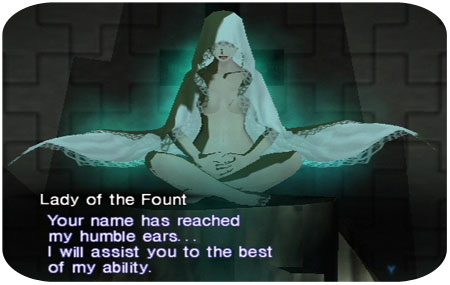Even in the post-apocalyptic Tokyo of Shin Megami Tensei III: Nocturne, healthcare is a pressing issue. When your lifestyle requires battling demons on a regular basis, you will quickly feel the need for dependable health services since the cumulative effect of multiple encounters within a short period of time will wear the party down.
The Vortex World’s primary healthcare provider is the Lady of the Fount, an underdressed medical professional with franchises in major cities and dungeons. These visits to recover HP and MP, revive the dead and remove curses require payment. Yes, even in a demon-infested world awaiting imminent rebirth there are enterprising profiteers. What she plans to do with all that money is an unexplained mystery. Clothes, perhaps?

(Original image source: Atlus.)
As far as the player is concerned, money will not be a problem by mid-game and the main healthcare concern is less about cost and more about convenience. With no rest mechanic in the game to allow the party to recuperate between visits to Dr. Half-Nekkid, the party must be self-sufficient to prevent attrition prematurely curtailing excursions into Nocturne’s many labyrinthine dungeons. The unpleasant alternative is backtracking to the Lady of the Fount (fighting demons all the way), healing the party then fighting all the way back towards the original destination only to find you need healing once again.
Go forth now and do not look back
There are two main methods of self-medication while out and about in the Vortex World. One is through the use of items purchased from stores or obtained as rewards after battles. While Medicine, Life Stones and Beads are common and cheap, items run out sooner or later which means instead of running back to the Lady of the Fount the player will be scurrying back to a store.
A better method is having healing skills like Dia, Media, Diarama, Mediarama, Diarahan and Mediarahan. But this is not without problems either. Healing skills require MP and MP, like the items used to replenish it, eventually runs out.
(Late in the game, players will find an item that is an inexhaustible source of MP but it can only be used during combat.)
The best option is to use skills synergistically. As the player character and his demonic posse only have 8 skill slots each, it’s imperative to choose skills wisely and find the right balance between offence, defence, healing and recovery in the party. The key to doing this is demon fusion, the art of combining two or more demons to craft a new one with some inherited skills.
You can certainly have the archetypical class triumvirate of warrior, nuker and healer in your party but the beauty of Nocturne’s demon fusion system is you can, with considerable patience and some planning, have a single party member versatile enough for all three roles. At the bare minimum, however, you will need a party member who essentially functions as an emergency medical technician with both a healing skill and the means to fuel it. This is essential if the party is to continually push forward.
There are a few indispensable MP replenishment skills in the game that provide MP during, between and after combat encounters. Mana Drain, the simplest of these skills, drains MP from a single foe in combat. Life Drain is a superior version of this as it not only drains MP from the targeted foe but HP as well. Mana Aid recovers a small portion of MP immediately after each battle while in-between battles, Mana Refill recovers MP over time as long as the character is in the active party. There are other skills but these are relatively common.
When an MP replenishment skill is paired with a healing skill and used judiciously, you will have a source of healing that never runs out and this will be the difference between Nocturne being pleasant gaming and Nocturne being an aggravating experience.
